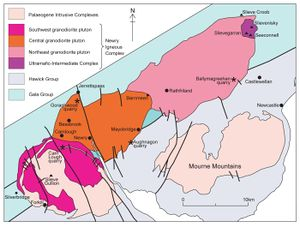Granodiorite plutons, Newry Igneous Complex, Late Palaeozoic intrusives, Northern Ireland: Difference between revisions
No edit summary |
No edit summary |
||
| (One intermediate revision by the same user not shown) | |||
| Line 22: | Line 22: | ||
<references/> | <references/> | ||
[[Category:Northern Ireland]] | [[Category:The geology of Northern Ireland]] | ||
Latest revision as of 12:28, 25 September 2017
| Mitchell, W I (ed.). 2004. The geology of Northern Ireland-our natural foundation. Geological Survey of Northern Ireland, Belfast. |
Introduction




Granodiorite forms the largest part of the Newry Igneous Complex and occurs in three distinct plutons. It is likely that several magma pulses were involved in the formation of each pluton [1]. While the northeast and southwest plutons have more basic margins and relatively quartz-rich central portions, the rocks of the central pluton show an opposite trend. Mineralogically, the granodiorites are composed of zoned plagioclase, microcline, quartz, hornblende, biotite and accessory Fe-Ti oxide, apatite, zircon and titanite. At the margins of the plutons the granodiorite has a penetrative, steeply inclined mineral foliation that is sub-parallel to the Silurian envelope rocks ( (P948109)). This deformation is not apparent towards the centre of the plutons ( (P948110)). Evidence of diapiric strain was produced at the margins of the complex at both its northeast and southwest ends by the ‘shouldering aside’ of the country rocks [2].
The normally zoned northeast pluton (P947810) extends from Slieve Croob to Barnmeen [J 173 327]. It is composed of medium- to coarse-grained granodiorite, with igneous and sedimentary xenoliths (enclaves) (P947987), and is exposed in Ballymagreehan quarry [J 305 354].
The reversely zoned central pluton (P947810) extends from Barnmeen to Bessbrook and typical lithologies are exposed in Aughnagon quarry [J 145 251]. At its exposed northern margin in Goraghwood quarry [J 066 319], near Jerrettspass, an early-formed marginal facies of porphyritic ‘rhyolite’ intervenes between hornfelsed and mobilised Silurian rocks and medium- to coarse-grained unfoliated biotite-hornblende granodiorite. The marginal granodiorite is notably more acidic than the rock at the centre of the pluton.
Much of the area between Bessbrook and Silverbridge is underlain either by granodiorite of the normally zoned southwest pluton (P947810) or by the Palaeogene Slieve Gullion Complex (see Palaeogene intrusive igneous rocks article). Its margin is exposed in Cam Lough quarry [J 037 246] and shows early microgranite, diorite and granodiorite (biotite granite) sheets intruding and hornfelsing Silurian country rock. A strong vertical fabric trending ENE, parallel to the pluton boundary, deforms the rocks in the quarry. The cross-cutting relationship between the southwest pluton and the Slieve Gullion ring dyke is also exposed here.
Newry Igneous Complex, Late Palaeozoic intrusives, Northern Ireland
References
- ↑ Meighan, I G, and Neeson, J C. 1979. The Newry igneous complex, County Down. In: Harris, A, Holland, C H, and Leake, B E (eds.). The Caledonides of the British Isles–reviewed. Special Publication of the Geological Society of London, 8, 717–22.
- ↑ Murphy, F C. 1987. Late Caledonian granitoids and timing of deformation in the Iapetus suture zone of eastern Ireland. Geological Magazine, 124, 135–42.